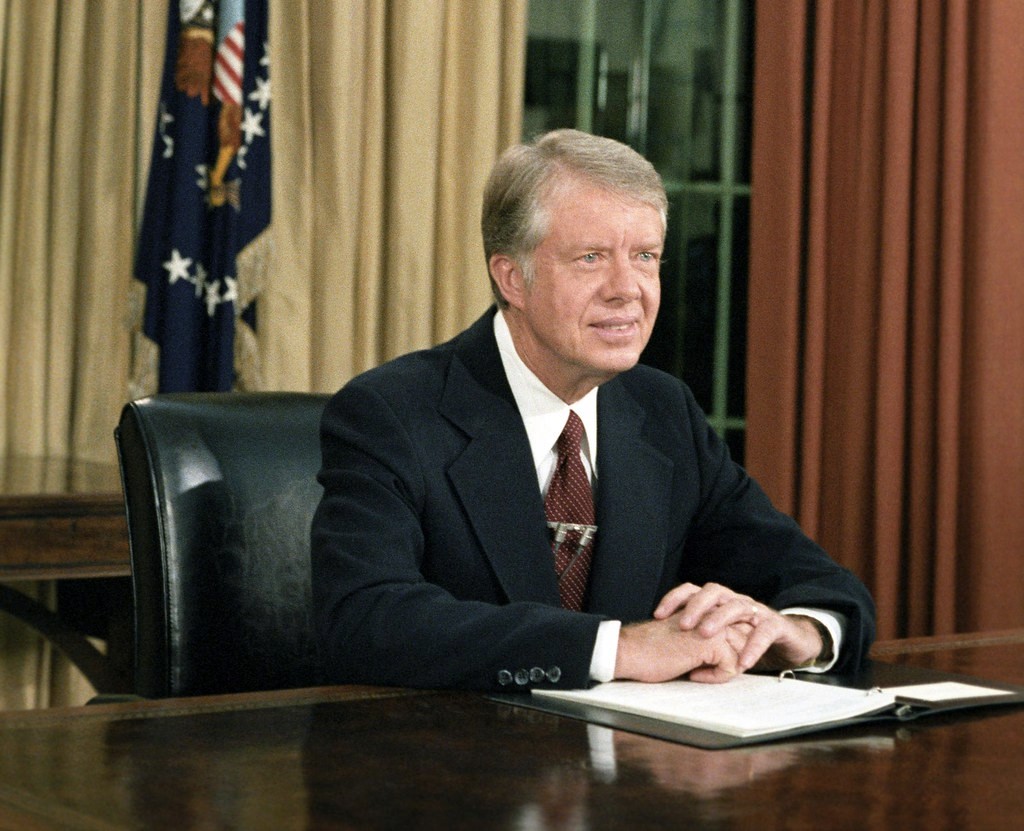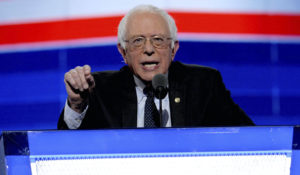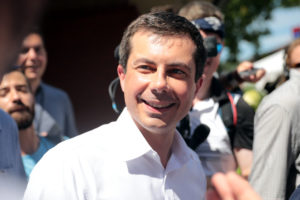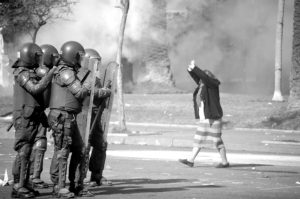American History for Truthdiggers: Carter’s Cage of Crisis
The 39th president was denied a second term largely by issues beyond his control—a bad economy and foreign tumult—and not by his own failings. Personal decency and morality did little to smooth the road for Jimmy Carter, president from 1977 to 1981.
Personal decency and morality did little to smooth the road for Jimmy Carter, president from 1977 to 1981.
Editor’s note: The past is prologue. The stories we tell about ourselves and our forebears inform the sort of country we think we are and help determine public policy. As our current president promises to “make America great again,” this moment is an appropriate time to reconsider our past, look back at various eras of United States history and re-evaluate America’s origins. When, exactly, were we “great”?
Below is the 32nd installment of the “American History for Truthdiggers” series, a pull-no-punches appraisal of our shared, if flawed, past. The author of the series, Danny Sjursen, who retired recently as a major in the U.S. Army, served military tours in Iraq and Afghanistan and taught the nation’s checkered, often inspiring past when he was an assistant professor of history at West Point. His war experiences, his scholarship, his skill as a writer and his patriotism illuminate these Truthdig posts.
Part 32 of “American History for Truthdiggers.”
See: Part 1; Part 2; Part 3; Part 4; Part 5; Part 6; Part 7; Part 8; Part 9; Part 10; Part 11; Part 12; Part 13; Part 14; Part 15; Part 16; Part 17; Part 18; Part 19; Part 20; Part 21; Part 22; Part 23; Part 24; Part 25; Part 26; Part 27; Part 28; Part 29; Part 30; Part 31.
* * *
There would never have been a Democratic president in 1977, certainly not a President Jimmy Carter, were it not for Watergate, Richard Nixon’s disgrace and the public backlash against Tricky Dick’s Republican Party. Indeed, after the fall of Lyndon B. Johnson, a new era of Republican ascendancy had begun, with the GOP holding the presidency for 20 of the 24 years following Nixon’s 1968 election. Often remembered as one of America’s most feckless and uninspiring presidents, Carter in reality was neither as successful as his supporters had hoped nor as ineffective as his opponents later claimed. He was, ultimately, a transitional figure and a product of the 1970s, which were increasingly politically conservative although heavily colored by cultural liberalism, especially among the young. Though later portrayed by the right as a hopelessly left-wing liberal, Carter was actually quiet pragmatic and became the first of the three Democratic presidents who served between 1977 and 2017 to tack toward the right. In that sense, one could argue that Carter reflected and affected the prevailing conservative winds and started the country down the road toward the “Reagan Revolution” and a long-term rightward trend in American politics.
A Georgia peanut farmer, Naval Academy graduate and evangelical Christian, Carter was a complicated, multifaceted figure and supposedly a figurehead of the “new”—post-civil rights—South. He was an intelligent, inherently decent man, but given the inflation and unemployment of the era—much of which was beyond his control—he seemed doomed to be a one-term president. He could not stem the tide of economic stagnation as the U.S. emerged from its anomalous postwar affluence. Indeed, in retrospect, the American economic expansion that followed the Second World War could not have continued without interruption. However, telling the truth about this inevitable phenomenon was not popular among a populace that had grown spoiled and expected unlimited perpetual growth. Carter tried to rein in that impossible expectation and for his trouble was voted out of office.
If not quite a tragic figure, Carter was, to some extent, treated unfairly by the voters, punished for crises and downturns not wholly of his doing. Then again, few remember that it was Carter who first shifted toward economic austerity and increased military spending and deployments in the Middle East. It is odd that the legacy of a man who seemed so committed to peace should be the onset of what would become a 40-year, ongoing crusade for American dominance of the Greater Middle East. It is more ironic, still, that a president later remembered as too liberal should be the first in many decades to call for a balanced budget and initiate monetary policies that emphasized austerity in more traditionally conservative ways. Though their personalities could not have been more different, Carter and his successor as president, Ronald Reagan, pursued policies not totally dissimilar to one another. Indeed, one could argue that Carter was the first in a line of three centrist Democratic presidents who would abandon the social program spending boom that had defined liberalism ever since Franklin Roosevelt’s 1933 inauguration. It could be said, then, that Carter was the first conservative president of a Republican-dominated era.
The Carter Anomaly: the Election of 1976
Carter was a long-shot candidate in the 1976 presidential election, a virtual unknown, but he was the beneficiary of a tragedy that had occurred half a dozen years earlier. The politician whom many Democrats wanted as head of the party ticket in 1976 had announced in September 1974 that he would not run. Sen. Edward M. Kennedy, a figure of the traditionally liberal consensus, had seemed destined to one day carry the torch of his assassinated brothers, John and Robert. However, his presidential prospects were crippled because the national public never fully forgave him for the so-called Chappaquiddick incident.
Late one night in July of 1969, the senator drove a car off a bridge in Chappaquiddick, Mass., then swam away. He did not report the accident to authorities until hours later. Left behind in the automobile was Mary Jo Kopechne, a former worker in Robert Kennedy’s campaign, who drowned there.
With Ted Kennedy not in the race, Carter gained the Democratic nomination with almost 40 percent of the popular vote in the primaries, defeating Jerry Brown, George Wallace, Mo Udall, Henry M. Jackson, Frank Church and others.
The former Georgia governor bested his Democratic rivals (including some other state-level politicians) and, eventually, Republican President Gerald Ford largely because voters saw him as being outside the Washington establishment, with which, after Watergate, Americans were increasingly disgusted. From his election on, arguably up to the present day, presidential candidates would run with and win with just such an “outsider” image.
The Republican Nixon had only recently, in 1972, trounced the Democrat George McGovern in one of the great landslides in American electoral history. It seemed unlikely then, at least until the Watergate scandal, that a Democrat would win in 1976. But times had changed. Americans, by and large, no longer trusted the federal government or establishment figures. The level of citizens who expressed faith in that government had dropped from 75 percent in 1964 to 25 percent in the late 1970s. What Americans wanted, in 1976, was someone new and fresh—essentially the anti-Nixon. They thought they had found that in the farmer from the tiny rural town of Plains, Ga.
Gerald Ford had become vice president when Nixon’s vice president, Spiro Agnew, resigned in disgrace in 1973 and then became president when Nixon resigned in disgrace in 1974. He had never won a nationwide election, and his campaign against Carter was shaky from the start. Though he confidently exclaimed that the “long national nightmare [of Watergate] was over,” most of the populace wasn’t so sure. And when Ford’s first act as president was to pre-emptively pardon Nixon he may have sealed his own political fate. As the editors of The New York Times wrote, “The pardon may be the final blow to [the people’s] faith in America.” Carter, the Cinderella-story candidate, rode that loss of faith in Washington, and particularly in the Republican Party, straight into the White House.
The 1976 election was a major coup for the Democrats, who picked up dozens of seats in the House and Senate, introducing a large freshman class dubbed the “Watergate babies.” The status quo, ostensibly, was the enemy of Carter and the young Democratic lawmakers. In style, if not always in substance, Carter would project an agreeable, more accessible figure. Seeking to distance himself from the “imperial presidency” of Richard Nixon, Carter even exited his limousine and walked among the people to the White House following his inauguration. In explaining the phenomenon of his out-of-nowhere victory, the new president said, “Our people were sick at heart, wanted leadership that could heal us, and give us once again a government of which we could feel proud.” At first, it seemed, Carter was just the man for this disillusioned moment. In addition to his man-of-the-people inaugural walk, Carter would seek to present a less regal presidency, ditching the Prussian-style uniforms Nixon insisted that his White House guards wear and even ending the tradition of playing “Hail to the Chief” upon his arrival at official events.
Carter’s morals, and devoted Christianity, also appealed to a nation becoming ever more religious. He was an evangelical churchgoer and a Sunday school teacher. Yet he was less forceful in his Christianity than a later host of Republicans who hailed from the growing “religious right.” As the journalist Robert Scheer noted after conducting a Playboy magazine interview with the then-candidate, Carter was “a guy who believes in his personal God and will let the rest of us believe whatever the hell we want.” Carter’s tolerance and lack of ideological dogmatism reflected his leadership style as well. He actually boasted he lacked ideology or fixed political positions, in contrast with the public proclamations of Nixon and Johnson. At election time in 1976, at least, Carter seemed just what the people desired: an honest, politically flexible outsider. Nevertheless, he had his weaknesses. Carter was seen from the outset of his term as bland and wonkish—certainly not inspiring.
For all the strengths that he did possess, and the short-term weakness of the disgraced GOP, Carter barely squeaked by to victory—probably a reflection of Americans’ rightward shift. He received just 50.1 percent of the popular vote in an election for which just 54.8 percent of voters—the lowest percentage since 1948—turned out. Thus, the new president hardly possessed a strong mandate to govern. Indeed, neither of the major-party candidates in the ’76 election seemed to excite voters. Both were weak public speakers. In fact, the liberal Democrat Eugene McCarthy, who ran for president as an independent in 1976, labeled Carter an “oratorical mortician” who “inters his words and ideas behind piles of syntactical mush.” Nonetheless, the “Man from Plains” entered office in January 1977 intent on broad systemic reform and with a goal to reinvest Americans’ trust in the presidency. As such, throughout his campaign, Carter had repeatedly proclaimed, “I’m Jimmy Carter and I’m running for President. I will never lie to you.” That, of course, remained to be seen.
The Great Malaise: Carter’s Domestic Policy
Carter was far less progressive in domestic affairs than either LBJ or John Kennedy, and certainly FDR. During his lone term, the president consistently waffled between traditionally liberal policies, and—partly as a response to shifting popular will as well as his own fiscal conservatism—by the time he left office had edged the nation to the right.
President Carter inherited an economy in near free fall. Overspending and borrowing for the Vietnam War, domestic oil shocks caused by Mideast nations’ embargoes (in response to U.S. support for Israel) and the expanding economic competition of other, growing nations combined to cause the nightmare of “stagflation”—the once-thought-impossible combination of high inflation and rising unemployment. Carter never managed to overcome this economic downturn, and that failure ultimately doomed his hopes for re-election.
The new president tried everything and even changed course on the economy. After calling for more typical liberal stimulus spending, he shifted after 1978 to more anti-inflationary policies such as spending cuts and balanced budgets. Neither effectively solved the deep-seated problems, at least while Carter was in office. Toward the end of his term, a desperate Carter would appoint Paul Volcker to head the Federal Reserve Board, and Volcker took drastic anti-inflationary actions, choking spending, aggravating unemployment and causing a recession. Eventually, however, the measures worked and inflation was drastically reduced, but it wasn’t until the assumption of the presidency by Ronald Reagan that Volcker’s harsh measures bore fruit, and the Republicans were quick to take credit. Timing was never on Carter’s side.
To the approval of liberals, Carter granted a limited pardon to Vietnam draft evaders. He also fought hard for environmental protection and saw the necessity to craft an energy policy that would make the U.S. less dependent on fossil fuels. He even had solar panels placed on the White House roof (which Reagan promptly removed). His national energy policy, largely crafted in secret, was eviscerated by corporate lobbyists and had little tangible effects. On energy, Carter was ahead of his time, but he misread the pulse of American life. He appeared on national television to speak truths that the gas-guzzling consumerist American people simply didn’t want to hear. “Tonight I want to have an unpleasant talk with you about a problem unprecedented in our history. With the exception of war, this is the greatest challenge our country will face during our lifetimes,” he said, adding, “The energy crisis has not yet overwhelmed us, but will if we do not act quickly.” However right and prescient Carter proved to be, the public didn’t take kindly to his call for cutbacks in energy consumption and resented his paternalist tone.
Carter took right-leaning positions on a host of other issues. A fiscal hawk by nature, he eschewed liberal spending and promised a balanced budget, something neither Republican Nixon nor Republican Ford had called for. He also proclaimed the limits of government to do great things and improve life. In one decidedly illiberal speech he asserted, “We have learned that more is not necessarily better, that even our great Nation has its recognized limits, and that we cannot answer all problems nor solve all problems. We cannot afford to do everything.” This caution was a far cry from the liberal utopianism of LBJ’s faith in his Great Society to transform American life and end its social and economic ills. Though Carter did initially call for stimulus spending and universal health insurance, he was never able to square these standard liberal policies with his own penchant for balanced budgets and the international economic crisis he weathered throughout his term. As his adviser Stuart Eizenstat later recalled, “One always knew that [Carter] wanted to spend as little money as possible, and yet at the same time he wanted welfare reform, he wanted national health insurance.” This proved to be an impossibility, especially in a time when a majority of citizens had no stomach for increased taxes and higher federal spending. Carter could never find a stable middle ground.
Furthermore, with increased foreign competition eviscerating the Rust Belt, and decreasing power among unions, even the overall rising standard of living under Carter was offset by ballooning inflation and increased unemployment. Furthermore, as unions lost clout and high-paying manufacturing jobs left the country, a new income gap rose between the rich and the rest. As working-class wages decreased by 13 percent in the 1970s and ’80s, the compensation of CEOs rose by nearly 400 percent. A new Gilded Age kicked off during the Carter years and has only worsened since. Labor union weakness and America’s gradual shift to a service economy meant stagnant wages, fewer benefits and fewer hours of pay for workers. For this, Carter had no effective answer.
Carter also began the trend of economic deregulation that would define the 1980s and ’90s. “It is a major goal of my administration,” he said, “to free the American people from the burden of over-regulation.” This process placed the American economy on the road to the unregulated hyper-capitalism that would eventually produce the 2008 economic crash. When the imminent failure of Chrysler, one of America’s top employers, added to the economy’s woes, many on both the left and the right were reluctant to back intervention despite the potential dire consequences of not doing so. One could hardly imagine FDR or LBJ shrinking from bold action to save Chrysler’s 250,000 employees. U.S. Rep. Ron Paul of Texas voiced a common sentiment among conservatives when he asserted that “[i]n a nation that is sinking in a sea of debt, it is irresponsible for this Congress to be considering a measure that will add millions to that debt.” On the left, unexpectedly, consumer advocate Ralph Nader agreed: “Mismanagement at the company has been incredible, why should a subsidy solve Chrysler’s problems? Let them go bankrupt.” Eventually, the feds provided $1.5 billion in relief for Chrysler, but only at the expense of a weakened union, which was forced to accept a wage freeze and, eventually, wage cuts.
Again, Carter took to the airwaves to chastise profligate Americans, stating, “In a nation that was proud of hard work, strong families, close-knit communities and our faith in God, too many tend to worship self-indulgence and consumption. Human identity is no longer defined by what one does, but by what one owns.” America’s biggest problem—more detrimental than inflation or energy issues—was a “crisis of confidence,” he declared, and once again Americans resented his brutal honesty and his calls for personal cutbacks in spending. And, though he never used the term, pundits dubbed it the “malaise” speech. It won him few popularity points in the long term.
Other limits to Carter’s purported liberalism manifested in his momentous deregulation of the airlines. Indeed, his very rhetoric circumscribed his view of what government could accomplish. To the horror of his liberal base, Carter proclaimed in his second State of the Union address, “Government cannot solve our problems. … It cannot eliminate poverty, or provide a bountiful economy, or reduce inflation, or save our cities.” Such pessimism was a far cry from the boundless faith in government that infused the presidencies of Franklin Roosevelt and his immediate successors in the Democratic Party. Indeed, according to the historian and former JFK adviser Arthur Schlesinger, if Roosevelt had believed these things “we would still be in the Great Depression.” But here again, Carter reflected the new national mood, one mistrustful of government. He promised much less than Americans expected and made perhaps the fatal error of asking Americans to economically sacrifice, the kind of plea that rarely has proved to be a political winner.
Carter’s personal attributes further held him back and doomed grand endeavors such as his energy plan. He refused to work closely with House Speaker Tip O’Neill, a fellow Democrat, and never developed close relationships with Congress. Instead, Carter relied on his small campaign staff from Georgia, refused to delegate, micromanaged, and occasionally displayed the arrogance so often inherent in loners and workaholics. He also alienated many on the left, especially the Congressional Black Caucus, with his fiscal conservatism and inherent distrust of unions (possibly a reflection of his upbringing in the notoriously labor-unfriendly South).
Beyond the domestic political problems caused by economic woes and Americans’ negative reactions to his chastising speeches, Carter was plagued by uncontrollable international events and criticism of his foreign policy. He would turn out to be the victim of tumultuous times in the international arena.
Schizophrenic Inconsistency: Carter and the World
Jimmy Carter is often remembered as particularly weak on foreign policy—soft on the Soviets and paralyzed by an inability to force revolutionary Iran to release hostages taken from the American Embassy in Tehran. Much of this criticism is wildly unfair. In point of fact, Carter had few options in ending the hostage crisis and was much more bellicose toward the Soviet Union (and supportive of increased military sending) than is now remembered. Carter may have failed in his foreign policies, leaving office with the Cold War frostier than ever and the world an arguably more dangerous place than he had found it, but this was certainly not because he was too soft or anti-military.
Carter was elected, purportedly, on a promise to re-inject morals and a concern for human rights into America’s tarnished, post-Vietnam foreign policy. He announced in 1978 that “[h]uman rights is the soul of our foreign policy, because human rights is the very soul of our sense of nationhood.” In some ways, especially early in his term, he attempted to decrease worldwide tensions and practice a rights-based foreign policy. At root, Carter was a Wilsonian internationalist idealist, at least in theory. He initially promised to cut aid to nations with poor human rights records, though he continued to back the brutal, but anti-communist, Shah of Iran. He also canceled the neutron bomb program and announced in his inaugural address, “We will move this year a step toward our ultimate goal—the elimination of all nuclear weapons from this earth.” To that end he negotiated the SALT II treaty with the Soviets to place limits on the total number of missiles and deliver systems for nuclear weapons that each power could possess.
In two other diplomatic coups, Carter officially recognized the People’s Republic of China, although this move upset conservative backers of the previously recognized Taiwan regime. Then, after many days of forced and closed negotiations, he negotiated the Camp David Accords, which brought peace between Israel and its archenemy, Egypt. Israel even agreed, under pressure, to return the conquered Sinai Peninsula to Egypt. Finally, Carter also signed an agreement to eventually return the Panama Canal to Panamanian control. This too raised the ire of conservative opponents—notably Ronald Reagan, who was particularly hawkish about the canal.
In the end, Carter failed to reduce tensions with the Soviets, and detente would die on his watch. Part of this was due to Soviet moves: placing new intermediate-range missiles in Eastern Europe and backing and using Cuban proxies in Angola and Ethiopia. Furthermore, new groups of American Cold War hawks—such as the alarmist Committee on the Present Danger—criticized Carter’s “cult of appeasement” and sought to increase bellicosity toward the Soviet Union. As for the SALT II treaty, it died in the Senate in the face of newly hawkish opposition from nearly all Republicans and a significant number of Cold Warrior Democrats.
Matters truly worsened when the Soviets invaded Afghanistan under what was in a sense a policy of defensiveness and insecurity rather than of inherent aggression—the Kremlin acted mainly to prop up a friendly communist regime. The United States had contributed to Soviet woes before the invasion by using the CIA to back Islamist rebels seeking to overturn the Afghan government, arming jihadists who would later coalesce into al-Qaida and the Taliban movements. In response to the Soviet invasion, the CIA only increased support, sending arms and cash to various rebel Islamist groups in an attempt to turn the Afghanistan War into the Soviets’ “Vietnam.” Carter and his advisers overreacted and came to (incorrectly) believe the Soviets had the intent and capacity to move through Afghanistan to conquer the Persian Gulf. Fearing a threat to American control of Mideast oil, Carter took serious steps to counter the Soviets. He embargoed grain shipments to Russia, reinstituted selective service and led an international boycott of the 1980 Olympic Games in Moscow.
Carter also took to using alarmist rhetoric, referring to the Soviet invasion and purported threat to the Persian Gulf as the “most serious threat to peace since the Second World War.” He proclaimed what came to be known as the Carter Doctrine, announcing that the U.S. would use military force to oppose any threat to Mideast oil in the Persian Gulf. In his 1980 State of the Union address, Carter said that “[the Middle East] contains more than two-thirds of the world’s exportable oil. … Let our position be absolutely clear: An attempt by any outside force to gain control of the Persian Gulf region will be regarded as an assault on the vital interests of the United States of America, and such an assault will be repelled by any means necessary, including military force.” Soon, Carter would even call for the creation of a new U.S. military command for the Mideast, later known as USCENTCOM. Thus, it was Carter’s overreaction that set the stage for a perpetual U.S. military presence—and several wars—in the Greater Middle East.
However, it was events in Iran that most embarrassed the Carter administration. For this there was an important backstory. The U.S. had long meddled in Iranian affairs, using the CIA to overthrow a democratically elected government that threatened to nationalize Iranian oil. In the place of Prime Minister Mohammad Mossadegh, the U.S. backed the brutal dictatorial regime of the shah. Few Americans knew or thought much about American actions in Iran, but Iranians never forgave Washington for these transgressions. Thus, when a 1979 revolution overturned the shah’s regime, and Washington refused to turn over the shah (being treated in the U.S. for cancer) to the new Islamist revolutionary government, a crowd stormed the U.S. Embassy in Tehran and took the staff hostage. Carter had few options to force the hostages’ release, and negotiations failed for over a year. Eventually, Carter allowed himself to be talked into a harebrained military rescue mission that ended in disaster and with several American deaths. In a final insult to Carter, the Iranian government waited until Reagan’s 1981 inauguration to release the hostages, a delay that contributed to Carter’s electoral defeat and fed the later (not wholly accurate) perception among Americans and others that a tougher and more bellicose Reagan was responsible for ending the Iran hostage crisis.
Carter’s foreign policy never lived up to his human rights-oriented rhetoric. It was Carter, not Reagan, who first increased U.S. military spending, began the shadow war with the Soviets in Afghanistan and buried the policy of detente. Carter may not have intended an increase in Cold War tensions, but he did allow himself to be pushed in a more combative and pugnacious direction by newly resurgent hawks in his administration and, especially, on Capitol Hill. Far from the dove he was pejoratively labeled as—then and now—Carter actually escalated America’s military buildup and helped usher in the last, but quite combative, final phase of the Cold War.
* * *
Some justifiable conclusions about Carter: that his failings as president were largely the results of personal style and a troubled era of global strife and economic downturn, much of it inherited. And that, despite later assertions from Reagan Republicans, his shortcomings stemmed not from his being too liberal but often more from his halfhearted attempts to shift rightward. One can, in fact, sense the end of liberal, optimistic, big-government politics in the Carter administration, as much as, or more than, in the Nixon administration. After Carter, conservative positions on economics and cultural matters became ascendant and mainstream. In many ways they remain so, despite the new, contemporary grassroots resurgence of the progressive left.
The record must be corrected to reflect that Carter, not Reagan, began the national shift toward smaller government, austerity, the end of detente and increased tensions with both the Soviet Union and Iran. We live in the political space created during the Carter administration, and have for some 50 years. Most of all, Carter’s stillborn presidency demonstrated that being inherently decent is not enough to weather hard times or win popular support, that Americans don’t take kindly to hard truths or demands for cutbacks in energy consumption and that this country remains, at root, a center-right nation—more conservative than the rest of the industrialized Western World.
In times since, Republicans have trotted out the specter of a feckless Carter to scare voters rightward, and it works! Carter’s legend of incompetence, more than his actual complex presidency, has stuck, demonstrating once again that memory is often more powerful than reality. In this way, Carter was a tragic figure in American history. He taught Republicans how to win and showed Democrats how to lose. They’re both doing so still.
* * *
To learn more about this topic, consider the following scholarly works: • Gary Gerstle, “American Crucible: Race and Nation in the 20th Century” (2001). • Kevin M. Kruse and Julian E. Zelizer, “Fault Lines: A History of the United States Since 1974” (2019). • Jill Lepore, “These Truths: A History of the United States” (2018). • James T. Patterson, “Restless Giant: The United States From Watergate to Bush v. Gore” (2005). • Bruce Schulman, “The Seventies” (2001). • Howard Zinn, “The Twentieth Century” (1980).
Danny Sjursen, a regular contributor to Truthdig, is a retired U.S. Army officer and former history instructor at West Point. He served tours with reconnaissance units in Iraq and Afghanistan. He has written a memoir and critical analysis of the Iraq War, “Ghost Riders of Baghdad: Soldiers, Civilians, and the Myth of the Surge.” He lives in Lawrence, Kan. Follow him on Twitter at @SkepticalVet and check out his podcast, “Fortress on a Hill,” co-hosted with fellow vet Chris “Henri” Henrikson.
Your support matters…Independent journalism is under threat and overshadowed by heavily funded mainstream media.
You can help level the playing field. Become a member.
Your tax-deductible contribution keeps us digging beneath the headlines to give you thought-provoking, investigative reporting and analysis that unearths what's really happening- without compromise.
Give today to support our courageous, independent journalists.






You need to be a supporter to comment.
There are currently no responses to this article.
Be the first to respond.